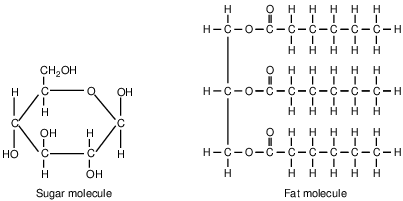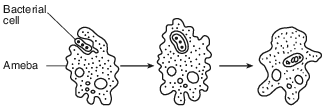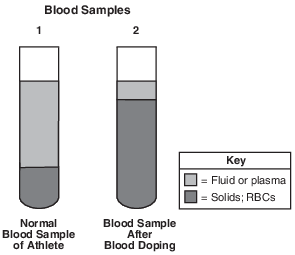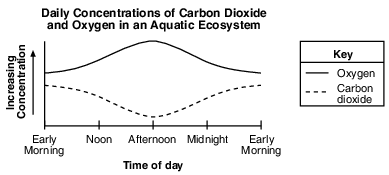Topic: Matter And Energy Flow Through Different Organizational Levels Of Living Systems
Matter And Energy Flow Through Different Organizational Levels Of Living Systems
Which group consists entirely of organic molecules?
(1) protein, oxygen, fat
(2) protein, starch, fat
(3) water, carbon dioxide, oxygen
(4) water, starch, protein
Organic compounds are used as building blocks for
(1) water, DNA, and starches
(2) water, proteins, and oxygen
(3) proteins, DNA, and carbon dioxide
(4) proteins, starches, and fats

The building blocks for this molecule are
(1) amino acids
(2) simple sugars
(3) fats
(4) molecular bases
Proteins, starch, and DNA are similar in that they are all
(1) organic compounds
(2) parts of genes
(3) made of amino acids
(4) made of simple sugars
The major role of carbohydrates in the human diet is to
(1) form the membranes that surround mitochondria
(2) act as a catalyst for cellular reactions
(3) supply energy for the body
(4) provide building blocks for amino acids
The two diagrams below represent a sugar molecule and a fat molecule that are used by living organisms.

Which statement best describes these two molecules?
(1) Sugar molecules are inorganic and fat molecules are organic.
(2) Sugar molecules are organic and fat molecules are inorganic.
(3) Energy for life processes can be stored within the chemical bonds of both molecules.
(4) Energy for life processes can be stored within the chemical bonds of sugar molecules, only.
More energy can be released from a fat molecule than from a glucose molecule because the fat molecule contains more
(1) genes
(2) organic compounds
(3) chemical bonds
(4) mitochondria
Organisms contain compounds such as proteins, starches, and fats. The chemical bonds in these compounds can be a source of
(1) amino acids
(2) simple sugars
(3) energy
(4) enzymes
Fat molecules typically contain long chains of carbon atoms. Animals tend to store fats for use when food resources are scarce. This is an advantage to the animal because
(1) much energy can be gained by breaking the bonds between atoms in the fats
(2) fats give off carbon dioxide that can be used by the muscles
(3) amino acids from fat synthesis are more easily digested than carbohydrates
(4) energy can only be created by digesting fats

This process is essential to the survival of the ameba because it
(1) provides materials used in cellular respiration
(2) removes pathogens from the environment
(3) supplies the raw materials for photosynthesis
(4) protects the organism during development
In the cells of the human body, oxygen molecules are used directly in a process that
(1) releases energy
(2) digests fats
(3) synthesizes carbohydrate molecules
(4) alters the genetic traits of the cell
Nutrients in a diet, such as proteins, carbohydrates, and minerals, play an important role in homeostasis within the human body. Lack of these nutrients can lead to malfunctions that disrupt this internal balance. Explain how diet can influence homeostasis. In your answer, be sure to:
• select a nutrient from the passage and write it on the line below and state one role this nutrient plays in the body [1]
• describe, using one specific example, how a decrease in this nutrient can alter homeostasis [1]
Nutrient: ________________________________
The student’s response to the bulleted items in the question need not appear in the following order.
• 12 Allow 1 credit for stating one role this nutrient plays in the body. Acceptable responses include, but are not limited to:
• — Carbohydrates are a source of energy. They can be used to produce the ATP needed for carrying out body activities.
• — Proteins are necessary for growth and repair.
• — Minerals are needed for strong bones and teeth.
• 13 Allow 1 credit for describing, using one specific example, how a decrease in this nutrient can alter homeostasis. Acceptable responses include, but are not limited to:
• — Decreased levels of carbohydrates might result in fatigue/less energy.
• — Lack of protein in the diet might lead to muscle loss/enzyme deficiency.
• — Lack of minerals might cause loss of bone density.
Hydrothermal Vent Communities
Scientists discovered a unique hydrothermal ecosystem on the sea floor at hot-water vents thousands of feet below the ocean surface. Organisms in these deep-sea regions have no access to sunlight, so they depend on the heat, methane, and high levels of sulfur-bearing minerals found in the heated fluids in which they live. Scientists were amazed to discover vent communities able to sustain vast amounts of life. The vent organisms depend on bacteria that can use the sulfur-bearing minerals to produce organic materials. These bacteria live on rock surfaces and as free-floating blobs. Some bacteria live within and provide nutrients for an unusual species of giant tubeworms that lacks a digestive system. Snails, shrimp, and clams are among the animals that feed directly on the bacteria. Crabs feed directly on other animals in the vent community.
Describe one way the bacteria of the hydrothermal vent community differ from plants in their ability to produce organic materials. [1]
Allow 1 credit. Acceptable responses include, but are not limited to:
• — The bacteria can use sulfur-bearing minerals instead of light to produce organic materials.
• — They can produce organic matter without sunlight.
• — The bacteria produce food without photosynthesis.
Blood Doping
Blood is a fluid tissue, which means that blood cells are suspended in a fluid called plasma. Blood tests are concerned with not only the number of blood cells present, but with the amount of plasma that surrounds the cells.
The diagram below represents tubes containing blood samples from an athlete before and after blood doping. Blood doping is an illegal practice reportedly used by some athletes a few weeks before an athletic event, and involves removing whole blood from an athlete, separating the oxygen-carrying red blood cells (RBCs), and then freezing them. These RBCs are thawed and returned to the athlete’s body just before the athlete competes. Serious health risks are associated with this practice.

Explain why athletes who practice blood doping would be expected to perform better at an athletic event. [1]
Allow 1 credit. Acceptable responses include, but are not limited to:
• — The practice increases the number of RBCs that would carry more oxygen to muscle cells.
• — Since muscle cells receive more oxygen for respiration, they would have more energy for
• the athletic event.
• — They would have more energy because they have extra oxygen.
A student measured oxygen and carbon dioxide concentration levels in an aquatic ecosystem during a 24 hour period. The data are represented in the graph below.

Identify two biological processes that are responsible for the production of varying amounts of carbon dioxide and oxygen within the aquatic ecosystem. [1]
Processes: ____________________________________ and ____________________________________
Allow 1 credit. Acceptable responses include, but are not limited to:
• — respiration and photosynthesis
• — photosynthesis and aerobic respiration
• — photolysis and respiration
